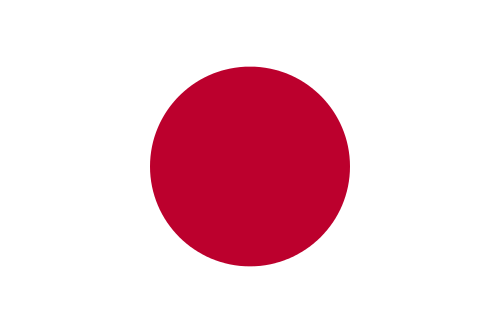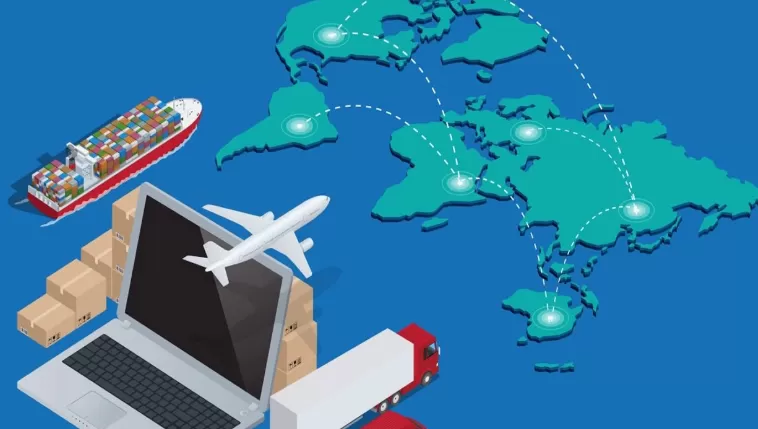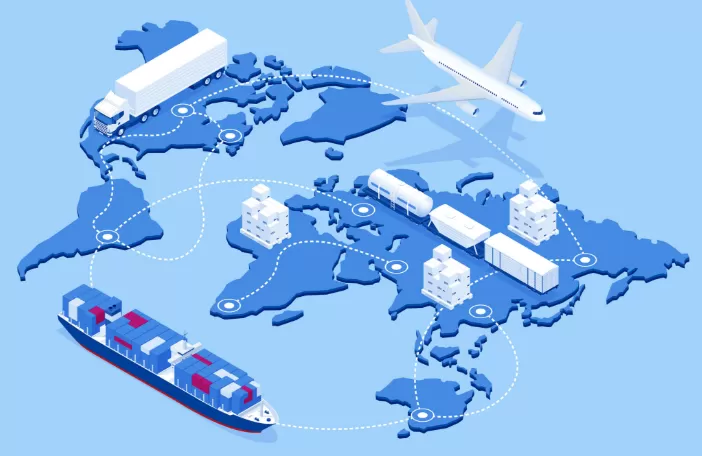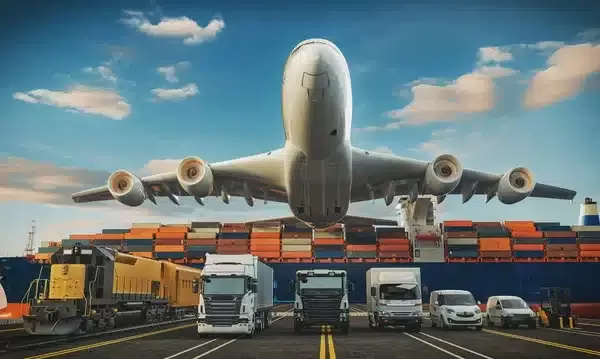Let's cut through the noise. You're here because you need to ship something from China without blowing your budget. You've probably found conflicting advice because everyone's cargo is different.
Here’s the truth: There is no single "cheapest" method. The absolute lowest-cost option depends entirely on a trade-off between your cargo's size, weight, urgency, and final destination. Anyone who gives you one answer without asking about these factors isn't giving you the full picture.
This guide won't just list options. It will give you the framework to make the smartest, most cost-effective decision for your business. By the end, you'll know exactly how to choose and how to avoid costly hidden fees.
Redefining "Cheap": It’s All About Total Landed Cost
Before we compare methods, you must understand what "cheap" really means in international shipping. The cheapest freight rate can become expensive quickly if you're hit with unexpected charges.
The only number that matters is your Total Landed Cost—the total expense to get your product from the factory floor to your destination door. This includes:
Freight Charge: The base cost to move the cargo (by sea, air, etc.).
Fuel Surcharge (BAF for sea/FAF for air): A carrier fee to offset fuel price fluctuations.
Origin Charges: Handling, documentation, and customs clearance fees at the Chinese port (e.g., THC - Terminal Handling Charge).
Destination Charges: The same handling, customs clearance, and port fees at the arrival port. These are often where budgets break.
Duties & Taxes: Government-imposed fees based on your product's value and type. This is critical: Who pays these? The Incoterms in your contract define this.
DDU (Delivered Duty Unpaid): You, the buyer, are responsible for paying duties and taxes upon arrival. This can lead to unexpected bills and delays.
DDP (Delivered Duty Paid): The seller (or your freight forwarder) pays all duties and taxes. This is often more expensive upfront but provides cost certainty and a hassle-free experience. For many businesses, a DDP service is the "cheapest" way to avoid logistical nightmares.
Insurance: While optional, it's a small percentage of the cargo value that protects you from total loss. Skipping it is a gamble, not a saving.
The Pro Insight: A freight forwarder quoting you a stunningly low ocean freight rate might be making up the profit on the origin/destination charges. Always, always ask for a detailed, all-inclusive quote.
The 4 Main Shipping Methods from China: A Deep Dive
Here’s a detailed breakdown of your options, far beyond the basic definitions.
1. Sea Freight: The Volume Champion
How it Works: Your cargo is loaded into containers. For smaller shipments, you use LCL (Less than Container Load), where your goods share a container with others. For large volumes, you book an FCL (Full Container Load) container for your exclusive use.
Real Cost: LCL is priced per cubic meter (CBM). FCL is priced per container. As of mid-2024, sample LCL rates from Shanghai to LA can be $80-$120/CBM. A 40ft container (FCL) might cost $3,800 - $5,200.
Pros: Unbeatable per-unit cost for large, heavy, or non-urgent goods. The only viable method for full container loads.
Cons: Very slow (25-45 days transit time). The most complex process with the highest number of potential fees (port charges, etc.). Vulnerable to port congestion and weather delays.
Who it’s for: LCL is ideal for shipments over 2 CBM or 500 kg. FCL is for anyone filling a 20ft, 40ft, or other container sizes.
2. Air Freight: The Speed & Balance Solution
How it Works: Cargo is transported in the bellies of passenger planes or dedicated cargo aircraft. It's measured by chargeable weight, which is either the actual weight or the volumetric weight (L x W x H (cm) / 6000), whichever is greater.
Real Cost: Priced per kilogram. Rates are volatile. Sample rates from Shanghai to Europe can range from $4.50 - $8.00/kg.
Pros: Fast (5-10 days transit time). Highly reliable schedules. Secure and global reach.
Cons: The most expensive mode per kg. Strict restrictions on dangerous goods. Cost fluctuates with fuel prices and market demand.
Who it’s for: Mid-weight cargo (150kg - 500kg), high-value products, perishable goods, or items with urgent deadlines.
3. Express Courier (DHL, FedEx, UPS): The Door-to-Door Simplicity
How it Works: Integrated carriers handle the entire process from pickup to delivery. They use their own planes, trucks, and customs teams.
Real Cost: The most expensive per kg, but incredibly efficient for small parcels. A 10kg box can cost $150 - $300.
Pros: Extremely fast (2-5 days door-to-door). unparalleled convenience and real-time tracking. Handles all customs paperwork seamlessly.
Cons: Prohibitively expensive for heavy items. Strict size and weight limitations for single pieces.
Who it’s for: Shipments under 30-70kg, urgent documents, prototypes, and high-value small parcels. The default for AliExpress/ePacket-style deliveries.
4. China-Europe Railway: The Strategic Middle Ground
How it Works: Part of the "Belt and Road" initiative, cargo travels in containers by rail from China to Europe (e.g., to Hamburg or Malaszewicze, Poland).
Real Cost: Priced per container. More expensive than sea but cheaper than air. A sample 40ft container rate might be $9,000 - $12,000.
Pros: Good balance of cost and speed (18-22 days transit). More environmentally friendly than air. Less susceptible to sea port congestion.
Cons: Geographic limitations (primarily for Europe). Can face bottlenecks at border crossings. Capacity can be limited.
Who it’s for: Shippers to Europe who find sea too slow and air too expensive.
freight forwarding
Get real-time quotes for
Get Quotes
Cheapest Shipping Method Comparison Table
| Method |
Approx. Cost |
Transit Time |
Best For |
Complexity |
| Sea Freight (LCL) |
$80-$150 / CBM |
30-45 days |
>500kg / >2CBM goods, non-urgent |
High (Many parties involved) |
| Sea Freight (FCL) |
$3,800+ / Container |
25-40 days |
Full Container Loads |
High |
| Air Freight |
$4.50-$8.00 / kg |
5-10 days |
150kg-500kg, Urgent, High-value |
Medium |
| Express Courier |
$5.00-$10.00 / kg |
2-5 days |
<70kg, Samples, Docs, Urgent |
Low (Handled by carrier) |
| Rail Freight (to EU) |
$9,000+ / Container |
18-25 days |
EU-bound cargo, Mid-urgency |
Medium |
The Final Answer: What's Cheapest for YOU? (Scenario Analysis)
Stop searching for one answer. Find your scenario below.
Scenario A: You're shipping small samples under 30kg.
Winner: Express Courier (DHL/FedEx/UPS).
Why: For tiny parcels, the convenience, speed, and all-inclusive door-to-door price make it the most cost-effective. Trying to ship a 5kg box via sea LCL would incur minimum charges and port fees that exceed the courier cost.
Scenario B: You're an Amazon FBA seller with 200kg of goods.
Winner: Air Cargo Charter Line (a type of air freight consolidation).
Why:This is the secret weapon for e-commerce. Freight forwarders consolidate many smaller shipments into one air container, offering rates better than express couriers and speed far greater than sea. It's the perfect balance of cost and speed for this weight class.
Scenario C: You need to ship over 500kg of machinery or furniture.
Winner: Sea Freight (LCL or FCL).
Why: The per-unit cost is undisputed. If you have enough volume to fill a container (FCL), you'll get the best rate. If not, LCL is your only logical option. You are trading time for significant cost savings.
4 Pro Tips to Actually Get the cheapest Rate
Be Precise: Provide your freight forwarder with exact dimensions, weight, and HS codes. Inaccurate info leads to revised quotes and delays.
Consolidate:If you have multiple shipments from different suppliers in China, use a warehouse in China to consolidate them into one larger, cheaper shipment.
Plan Ahead:If you can be flexible with your timeline, you can book during off-peak seasons or choose slower transit times for better rates.
Build a Relationship:Find a reliable freight forwarder you trust. Their expertise in routing and negotiation will save you more money in the long run than chasing the absolute lowest quote from an unknown agent.
Conclusion: It's About Optimization, Not Just Price
The cheapest way to ship from China isn't a mystery; it's a calculation. It's about precisely matching your cargo's profile and timeline with the most efficient mode of transport while understanding all potential costs.
The goal isn't to find the lowest number on a quote sheet—it's to achieve the lowest total landed cost that supports your business goals.
Still weighing the options? You don't have to.
The easiest way to find your most cost-effective solution is to get expert advice tailored to your specific needs.
freight forwarding
Get real-time quotes for
Get Quotes
Exploring Shipping Guides for Other Key Destinations?
While this guide provides a universal framework, optimizing your strategy for a specific destination can yield greater savings. We have detailed guides for major logistics hubs across the United States and Europe.
United States Overview: Comprehensive US shipping guide with FBA specifics and nationwide trends.
European Markets: Strategies and best freight forwarders for European FBA markets.
Key US Gateway Hubs: Dive into the specifics of major ports like New York, Los Angeles, and Chicago.
UK Specific: Strategies for shipping to Birmingham for affordable Amazon FBA options.
Logistics Models: Understand 1PL, 2PL, 3PL, 4PL differences to better structure your supply chain.
Compare All Options
Each destination offers unique advantages depending on your cargo type and final distribution needs. Use our detailed guides for Baltimore, Miami (via Jacksonville), and other major logistics hubs to develop an optimal strategy.
Frequently Asked Questions (FAQ)
1. Q: How do payment terms (like FOB or EXW) affect my shipping costs?
A: They significantly impact who pays what. With EXW (Ex-Works), you, the buyer, are responsible and pay for all costs from the factory door onward. With FOB (Free On Board), your costs start once the goods are on the vessel. FOB can sometimes be simpler, but EXW might give you more control to choose your own freight forwarder and potentially negotiate better rates for the main leg of shipping.
2. Q: My goods are oddly shaped (e.g., long pipes, machinery). Will that cost more?
A: Almost certainly. Non-standard dimensions can lead to "out-of-gauge" or "awkward cargo" surcharges. This is because they may require special equipment to load, take up more space than their weight suggests, or cannot be stacked, reducing the carrier's capacity. Always provide full dimensions upfront for an accurate quote.
3. Q: What's the difference between a freight forwarder and a customs broker?
A: A freight forwarder specializes in the physical transportation of your goods, coordinating the move from origin to destination. A customs broker is licensed and specializes in clearing your goods through customs. Many companies (like us) offer both services as an integrated solution, which is highly recommended for a seamless process.
4. Q: Can I ship batteries or other restricted items cheaply?
A: "Cheap" is relative. Shipping restricted items like batteries, liquids, or magnets is always more expensive than standard cargo. They are classified as "dangerous goods" (DG) and require special handling, documentation, packaging, and labeling, which incurs additional fees. The cheapest part of this equation is getting the packaging and documentation 100% correct to avoid massive fines or rejection.
5. Q: How does the season or time of year affect shipping costs?
A: Demand hugely impacts price. The peak season (typically July through October, ahead of Christmas) sees rates skyrocket due to high demand for space on vessels and planes. Chinese New Year (January/February) causes a complete shutdown for weeks, creating a massive rush before and after. Shipping during off-peak periods (e.g., Spring) can yield significantly lower rates.
6. Q: What happens if my goods arrive at the destination port before my documents do?
A: This is a serious problem called "arrival without documents." It will cause significant delays and incur costly storage demurrage charges at the port until the documents are presented for clearance. Using a professional forwarder ensures documentation is processed electronically and arrives on time, avoiding these fees.
7. Q: Is it cheaper to ship to a port or to an inland city?
A: Shipping to a major port is always cheaper. Adding inland transportation (via truck or rail) to a final destination inland city will add to the cost. This is known as a "door-to-door" service versus a "port-to-port" service. You must compare the total landed cost for a true picture.
8. Q: What is a 'Phytosanitary Certificate' and will I need one?
A: This is an official document required for shipping goods derived from plants (wooden furniture, bamboo products, certain food items, etc.). It certifies the products are free from pests. If your goods require one and you don't have it, they will be held or destroyed by customs. Your freight forwarder can advise if your products fall under this category.
9. Q: Can I pack different products into one box to save money?
A: You can, but with caution. For customs declaration, each product type inside the box should be listed individually with its own HS code and value. Consolidating into one box can save on volumetric weight charges, but improper declaration can lead to customs delays and problems. Professional consolidation services handle this correctly.
10. Q: How do you calculate volumetric weight for my shipment?
A: It's a standard formula that calculates the density of a package. Because aircraft and cargo space are limited by volume, not just weight, carriers charge based on which is greater: the actual weight or the volumetric weight.
For Air Freight: (Length x Width x Height in centimeters) / 6000 = Volumetric Weight in kg.
For Express Courier: (Length x Width x Height in centimeters) / 5000 = Volumetric Weight in kg.
For Sea Freight (LCL): CBM (Length x Width x Height in meters) is used, and they typically have a conversion ratio of 1 CBM = 1000 kg.

 EN
EN
 FR
FR
 ES
ES
 JA
JA
 PT
PT
 RU
RU
 AR
AR







